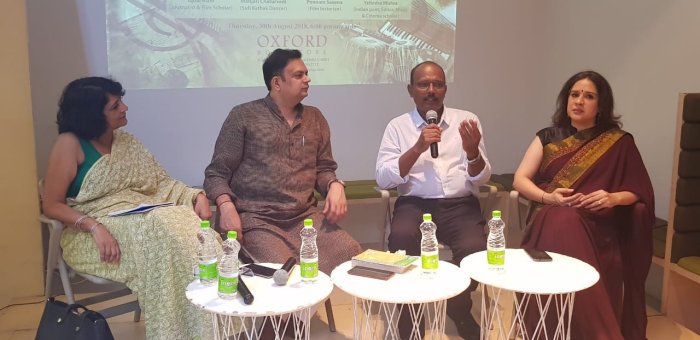
|   |

|   |
Mehfils of today and yesteryears - Kasturika Mishra e-mail: kasturika69@gmail.com September 19, 2018 Why has Indian cinema changed so much that the relevance of mehfils has lost the resonance in the society? Why do we no longer respond to archival Indian classical traditions of thumris and tawaifs when we so easily respond to the same mujra songs being enacted in Indian cinema by a renowned actress? On August 30, 2018 at the Oxford Book Store in Delhi’s Connaught Place, the dialogue that ensued with Poonam Saxena (film historian), Iqbal Rizvi (journalist and film scholar), and interspersed by Manjari Chaturvedi (Sufi Kathak dancer) in ‘Film Sangeet aur Mehfil’ hovered on this aspect of cinema. What is “classy” and what is “massy”? If you know your film is catering to front benchers morning show crowd a “bidi jaleile” would fit in the audience psyche, whereas the class of people who remember Meena Kumari and “Chalte chalte” would like that as the ultimate succor to the mind space of mehfil. Iqbal Rizvi said that the informal soirees at homes are also mehfils and are miniature versions of the movies we watch. Anybody with a tilt of musical sense could be coaxed to sing in a family get together, ladies’ sangeet and pass on the same feeling. Cinema and real life are each drawn from each other’s social values and situations. Manjari Chaturvedi wanted the tawaif to be treated with respect just as she was hated in the times of Nawabs. She said that courtesans of yesteryears are forgotten by citing the example of Mirasans of Lucknow. She is in process of researching about courtesans and is putting in effort to familiarize the culture among the literati.  Poonam Saxena threw light on how piano music was a corollary in movies of 1970s where it was a kind of mehfil too. Only that the cameras and heroines zoomed in and out of the context of the songs being sung. She also detailed how in quawaalis also the same sawaal-jawab of mehfils is played between males and females and it was an off shoot of the mehfils of the gullies of kothas. Prashant Kashyap pointed out the Baazaar film song also as a flag-post of Indian mehfil songs. An interesting observation was that everybody in the audience was on a nostalgic film journey picking up points from their own cinematic journey. Kasturika Mishra is a cataloging specialist librarian, writes reviews on the performing arts, and is advisor to Kalinga Literary Festival, Bhubaneswar. |